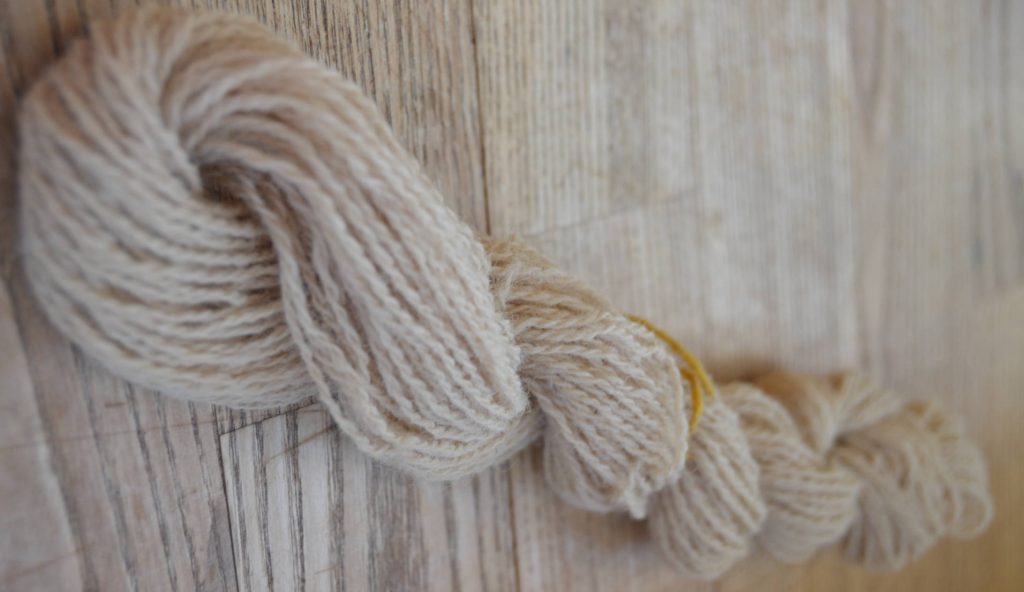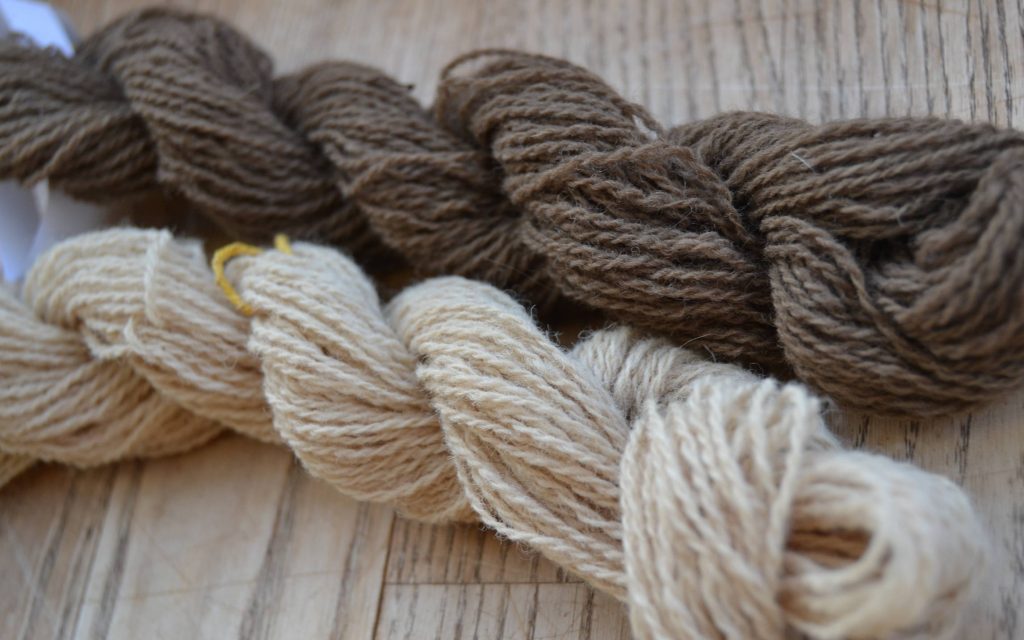Jeg boede i Grenoble i 2 år, og alle talte altid om valnødder. Området er da også berømt for sine valnødder – noix de Grenoble. Jeg må indrømme at jeg hverken så træerne eller spiste særlig mange nødder mens jeg boede der…
Så en dag her i Danmark, da jeg så en stor sæk noix de Grenoble i supermarkedet måtte jeg købe den. Nødderne er forlængst spist, men jeg havde læst et sted at skallerne kunne bruges til at farve med (ud over at man kan farve med de bløde yderskaller fra valnød, men det er noget andet).
Jeg kan godt lide ideen om reddede farvestoffer, farver i materialer, der ellers bare ville blive smidt ud. Jeg havde ca 500 g valnøddeskaller

Jeg fulgte denne artikel og lagde skallerne i blød i vand et par døgn. Så kogte jeg dem et par timer. Næste dag fjernede jeg skallerne og farvede et alunbejdset 10-grams fed i farvebadet i ca. en time. Det så faktisk godt ud i badet, men efter det var vasket og tørret var det bare en lys beige:

Sådan en farve der godt kan bruges til farvestrik, men ikke er ret spændende i sig selv! Jeg havde håbet på en mørkere brun, men det er rent faktisk en af de svære farver at få frem med naturlige farvestoffer.
FACTS – VALNØDDESKALLER
Bejdsning 10% alun
Vand Vandhane
Garn Supersoft 575 m/100 g
Forhold garn:farvestof 1:50
Konklusion Et elendigt farvestof
Mulige forbedringer Svært at få øje på – andet end at glemme skallerne og prøve at indynde sig hos nogen med et valnøddetræ, så man kan få fat på yderskallerne
Sidste år fik jeg en rigtig flot brun med svampefarvning. Her er den nyfarvede lyse beige ved siden af den flotte brune fra sidste år:

Det brune fed er farvet med svampen gran-tjæreporesvamp (Ischnoderma benzoinum) som ikke er så sjælden. Den er nævnt i “Färgsvampar & svampfärgning” af Hjördis Lundmark og Hans Marklund, men det kan også være at det er dens slægtning løv-tjæreporesvamp (Ischnoderma resinosum). Jeg har ikke et billede af svampen jeg brugte, men jeg vil lede efter den igen næste år.
Hi…Julie Nutt here…I am reading your site on natural dying and looking at all of your beautiful colors and PROJECTS!!! I am so impressed…The way you have used your dye samples is great…I wish I had thought of it!! I mixed a lot of my natural dyes into one yarn and although it is pretty…it wasn’t what I wanted to show off the individual colors!! I have plenty of Black Walnut trees around me ….I get some beautiful colors from the hulls, leaves, stems and bark…many gradients of browns. I have some that have dried in a bag from a year ago…and because of they drying they are light weight….I was wondering would you like me to break it all down into powder and send to you? I would keep the leaves, stems and hulls all separate from each other. I would be happy to do it for it is nice to find a kindred spirit in the natural dye world. I have never used the dried product from my black walnut trees (Juglans nigra)so I am not sure what kind of color you would get but you could give it a try…I take pictures of all of my dye experiments. I like you grab what I see on walks and bring it home to give it a try to see what color I get…even if it is not in anyone’s dye book or experience…I am always learning something new…I will do what you have done with the colors…keep them separate, spin them and knit them separately…Your blanket and hat are great idea’s and beautiful work…
Hi Julie,
Thank you so much for your kind words! I have to admit that I did actually spend a lot of time (my family thinks too much!) thinking about the best way to knit up my yarn samples. I also searched around a lot for patterns, but didn’t find anything that would show each separate color in a recognizable way. With ordinary yarn, that doesn’t matter, but with naturally dyed yarn I do think it’s half of the joy to recognize the exact yarn in a project. And then you remember the plant, the exact weather and spot where you picked it, who went on the trip, what you talked about…
I would absolutely LOVE to try your black walnut! I’m quite sure that it doesn’t grow here, and even ordinary walnut (which I think does not give as deep a brown color) is rare! Walnuts only hit the shops here around Christmas time, and they are all from Grenoble. It’s actually on my long term wish list to grow both kinds (but if I am to make any progress with that wish list, I think I’ll need quite a lot of land)